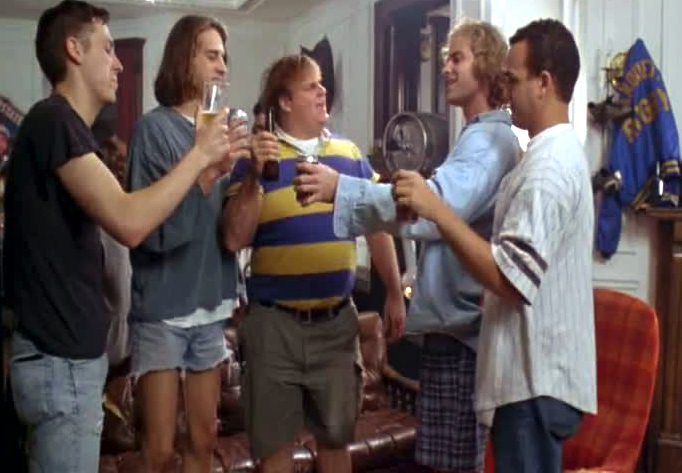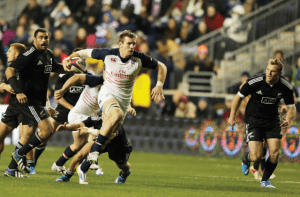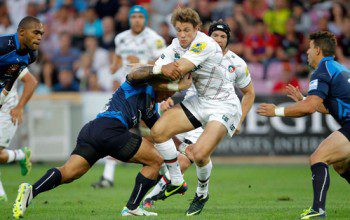

PHILADELPHIA, PA – In September, ESPN posted an article about rugby. While I am always happy when rugby gets attention, it’s disappointing to see some of the quality of the attention. Based on the upcoming November 1 match in Chicago between Team USA and New Zealand, it was predictable that there would be some “regular” sports media attention.
Let’s take a look at that article and, as gently as possible, fill in the gaps and point out some common mistakes made when non-rugby-loving Americans write about rugby.
WHEN A CHAMPIONSHIP steps onto Soldier Field on Nov. 1, it won’t be the Seahawks — it’ll be the world’s top-ranked rugby squad, New Zealand, facing the 18th-ranked Americans in what USA Rugby CEO Nigel Melville calls the “biggest game in U.S. rugby history.”
This first sentence, presumably, should be “When a champion steps onto Soldier Field.” In a general sense, being the top ranked team in the world is like being a champion. More relevant to their status as champions: they won the 2011 World Cup, the 2012 and 2013 Rugby Championship, and will probably win the 2014 Rugby Championship. This sentence actually undersells how good they are, and it doesn’t acknowledge that they are also the best rugby brand off the field. It is, for a fact, the biggest game in U.S. rugby history.
With some 55,000 tickets sold so far, it’s crushed the U.S. home rugby attendance record of 20,181.
Yep. It is going to be awesome! That home record actually flatters the experience of many games. If you have ever watched the Eagles lose by 80 to Ireland in little Singer Family Park in Manchester, NH, the idea of watching them at a sold out Soldier Field is like a different universe.

Think rugby is just a shirt style? With help from ESPNscrum.com, we tackle your ignorance.
Maybe it is just me, but it seems that most sports fans can handle that rugby is both a sport and a kind of shirt. Like polo. One of the things that happens when rugby is explained to non-rugby-lovers is that things are dumbed down. The other thing that happens is a lot of analogies to football. Neither is all that helpful.
1) What the heck is going on?
It’s 15 players per side, two 40-minute halves. You advance the ball by running or kicking it downfield. Laterals are OK, forward passes are not (think Stanford-Cal’s The Play).
Not really. But as promised: football analogies. That play, The Play, was chaos, a fluke, a bunch of guys trying desperately to win a football game following the rules of football against other football players. It was awesome, but it wasn’t like rugby.
You get three points for a dropkick through the uprights (think field goal),
There is a thing in rugby that resembles a field goal. Of all of the things from football to be described as a similar thing in rugby, the field goal is the best thing. However, field goals and drop kicks aren’t similar in any way other than being worth three points. The thing that is like a field goal is an option teams have following a penalty committed by the other team. A dropkick is taken during open play and is not like a field goal. Penalty kicks are common; successful drop kicks are relatively rare.
…five for running the ball past the goal line and setting it down for a try (think TD), two for the kick-after. Easy!
It seems odd to go with TD and not to write out touchdown. The football term comes directly from rugby and rugby’s law that the score has not happened until the ball is touched down.
5.6: Meters of distance between the goalposts on a standard rugby field, the same as in the NFL.
There are a lot of numbers worth caring about and that can help explain the game. This does not seem to be one of them.
2) So what’s with those scrums?
After violations, the ball is rolled between the two sides; eight players from each team huddle and try to push each other back to grab it.
Huddle suggests a casual clump, and with the football analogies it suggests a football huddle. A scrum is a highly organized way to restart play. In addition, once the ball is in the scrum, no one can grab it. It is hooked (by the hooker) toward the back of the scrum. Only when it is there at the back of the scrum can it be grabbed.
Even more fun? When the ball goes out of bounds for a throw-in, the two teams line up a meter apart. As the ball is tossed into the air, players fling their teammates upward to try to gain possession (think full-contact cheerleading).
Lineouts are fun and they often make for great pictures. They are another highly organized way of restarting play. I don’t know what lineouts have to do with cheerleading. Jumpers aren’t thrown; they are lifted.
17: Average number of scrums per match in the 2011 Rugby World Cup (won by New Zealand, of course).
This is another number with no context. Scrums can slow the game down, and some people find them a pretty boring aspect of the game. (I am not one of those people.) However, the number 17 doesn’t tell you that or even if that is a lot. I watch a lot of rugby–including games in which I log and takes notes on every scrum–and I had to look up how that 17 compares to other averages in other competitions. Turns out? Pretty average.
3) What’s the key to the Kiwis?
In their first official match ever, in 1903, the Kiwis defeated Australia 22-3. And they haven’t lost much since, winning 76 percent of international matches in their history. Today, New Zealand may be the most rugby-mad country on the planet, and the All Blacks are as good as ever, having gone undefeated in their last 20 matches. In their last 41, they’ve lost only once.
This paragraph doesn’t seem to answer the question. It is important to understand that rugby is a big deal in New Zealand. It is also important to note that many of the All Blacks are pretty darn excited to play in America. The key to how the US will compete will depend on who is in the All Blacks’ squad. That won’t be announced for a while.
No mention of the Haka?
Everyone loves the Haka. There are all kinds of Haka to talk about. Last year when the Maori All Blacks played the US (at a sold out PPL Park in Philadelphia) the crowd chanted “U-S-A! U-S-A!” and drowned out the Haka. I had chills up and down my arms.
4) Is there a chance we might win?
Uh, no. U.S. coach Mike Tolkin compares the match to minor leaguers playing the ’27 Yankees.
That seems an odd comparison. I think a better comparison is the USA basketball team playing the New Zealand basketball team. We know who is going to win that one, even if some of the best players in America stay home. And with that comparison, more Haka.
12: Number of international teams, according to Tolkin, that can compete with New Zealand.
I am not sure what Tolkin means by compete. There are fewer than 12 teams in the world who have a real shot at beating the All Blacks at the moment.
5) rugby: The future sport of the future?
A few years ago, when U.S. star Samu Manoa was playing for a San Francisco club, he had to work as a cement mixer to pay the bills. But interest is growing. And to be fair, we are the reigning Olympic champs; the sport last appeared in the ’24 Games, and our boys took gold. That’s news only because rugby is making a return to the Olympics in 2016.
It doesn’t actually seem fair to bring up the Olympics. It was in 1924. The tournament was a mess. Thinking this matters is like bragging about being unbeatable at Monopoly without telling the world you only play with your pre-pubescent children. The rugby that will be played in Rio is 7s. Related, but different. Manoa is one guy whose success, though total and awesome and totally awesome, doesn’t seem to indicate an entire sport’s growth.
83 Percent: Increase in U.S. rugby participation from 2007 to 2010, according to a 2011 study.

That indicates growth. Also, there are about 20 guys abroad in either fully professional or semi-professional situations who have recently or probably will soon play for the Eagles. As far as I can tell, that is the biggest number ever and that seems to be a good sign for the near future.
6) Who should I watch?
That Manoa guy. He was spotted three years ago by a scout for a team in England’s Aviva Premiership and has since emerged as a powerhouse. This past season, he was a finalist for the league’s player of the year award. At 6-6, 269 pounds, he has said, “Hitting people is what I like.” But Manoa also runs the ball well and has deft hands and a heralded rugby IQ.
Manoa is a beast, but also fun to watch? Blaine Scully.
If you are reading this fall about rugby from non-rugby-loving sources, be warned: look out for the football analogies, the Olympics reference, and, though it is missing here, the U.S. as the “sleeping giant.” If you see those things, move on.
That’s it for now. Feel free to comment below, please look for and “Like” our Facebook Rugby Wrap Up Page and follow us on Twitter@:RugbyWrapUp, Junoir Blaber, Nick Hall, James Harrington, Jamie Wall, Jaime Loyd, DJ Eberle, Cody Kuxmann, Karen Ritter, Jake Frechette and Declan Yeats, respectively.

